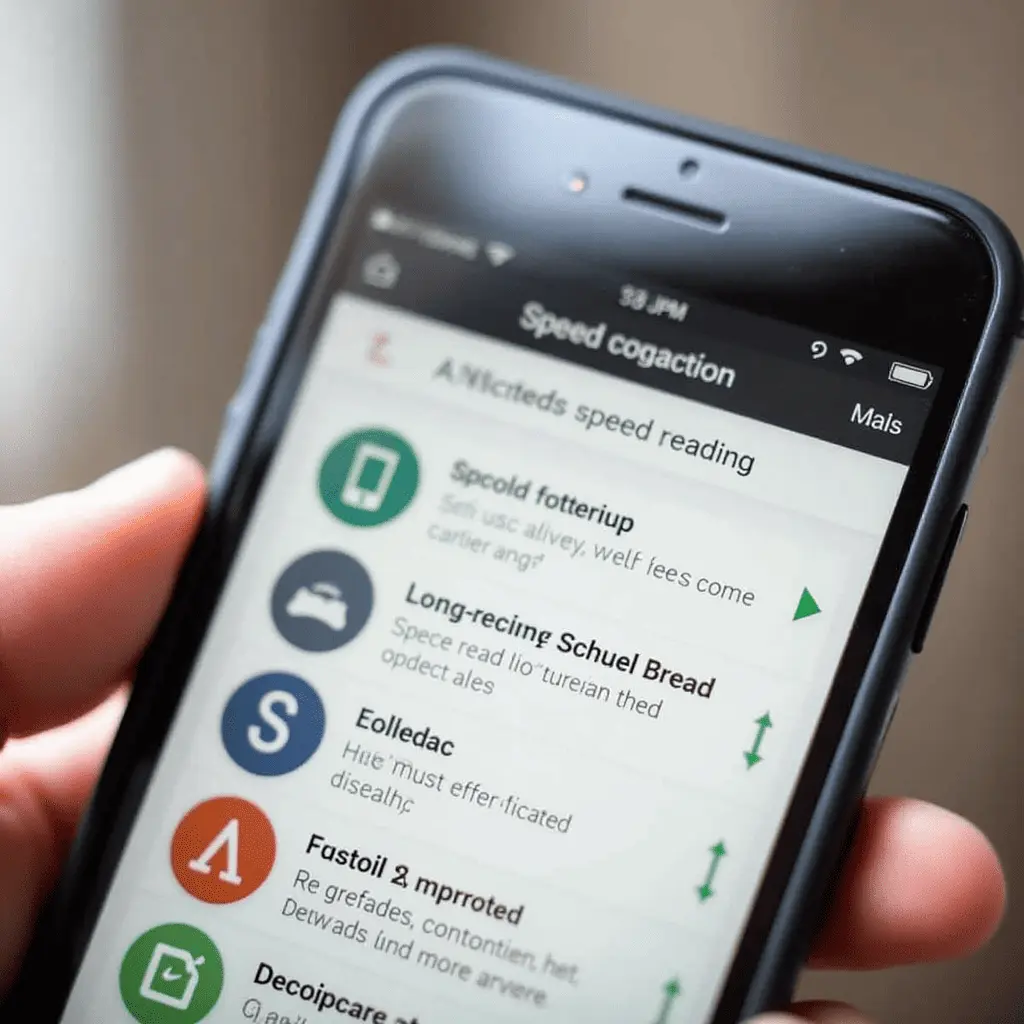Emotionally Resonant Opening
Do you ever feel overwhelmed by the sheer volume of information you need to read every day? Whether it’s for work, school, or personal growth, the struggle to keep up with your reading list is real. What if you could read twice as fast—or even faster—while still retaining all the important information? Speed reading isn’t just a skill for geniuses; it’s a learnable technique that can transform the way you absorb knowledge.
Imagine this: the average person reads 200-300 words per minute, but with speed reading techniques, you can double or triple that number. Think about how much time you could save and how much more you could accomplish. In this article, we’ll explore proven strategies to boost your reading speed, improve comprehension, and save you hours of time. Let’s dive in!
Table of Contents
What Is Speed Reading?
Speed reading is a collection of techniques designed to increase the rate at which you read without sacrificing comprehension. Unlike traditional reading, which often involves subvocalization (saying words in your head as you read), speed reading encourages you to process information in chunks and use your peripheral vision to take in more text at once.
The Science Behind Speed Reading
Speed reading leverages the brain’s ability to process information quickly. When you read, your eyes move in small jumps called saccades, pausing briefly to take in information. Traditional reading involves many of these pauses, but speed reading reduces their frequency by training your eyes to take in more words at once. This technique is supported by research showing that the brain can process visual information much faster than we typically read.
Historical Context
The concept of speed reading isn’t new. It gained popularity in the mid-20th century with the work of Evelyn Wood, who developed a method that could significantly increase reading speed. Her techniques have been refined over the years, and today, speed reading is a well-established skill taught in various courses and programs.
Benefits of Speed Reading
Save Time
One of the most obvious benefits of speed reading is the amount of time you can save. Consider this: if you double your reading speed, you can cut your reading time in half. For someone who reads for two hours a day, that’s an extra hour every day—time that can be spent on other activities, whether it’s work, hobbies, or spending time with loved ones.
Improve Productivity
In a professional setting, the ability to read quickly can be a game-changer. Imagine being able to get through emails, reports, and documents in half the time. This not only makes you more efficient but also reduces stress and allows you to focus on higher-priority tasks.
Enhance Learning
For students and lifelong learners, speed reading can be a powerful tool. It allows you to absorb more information in a shorter period, making it easier to keep up with coursework or stay informed in your field. Additionally, speed reading techniques often improve comprehension and retention, making your study sessions more effective.
Myth Busting
Myth: Speed reading means skimming and missing important details.
Fact: When done correctly, speed reading enhances comprehension by teaching you to focus on key ideas and eliminate distractions. Skimming is a different technique that involves quickly looking over text to get the gist, whereas speed reading involves actively engaging with the material at a faster pace.
Myth: Speed reading is only for naturally fast readers.
Fact: Speed reading is a skill that can be learned and improved with practice. While some people may have a natural inclination towards faster reading, anyone can develop this ability with the right techniques and consistent effort.
Why Reading Speed Matters
In today’s information-driven world, reading speed is more important than ever. Consider these statistics:
- The average professional spends 2-3 hours a day reading emails and documents.
- Students often need to read hundreds of pages of material each week.
By improving your reading speed, you can cut that time in half, giving you more time to focus on what truly matters. But speed reading isn’t just about reading faster—it’s about retaining more information efficiently. Imagine being able to read a book in a single sitting and still remember the key points weeks later. That’s the power of speed reading.
The Role of Technology
With the advent of digital media, the amount of information we need to process has skyrocketed. From social media feeds to online articles, the sheer volume of content can be overwhelming. Speed reading techniques can help you navigate this deluge of information more effectively, allowing you to stay informed without feeling bogged down.
Proven Techniques to Boost Your Reading Speed

1. Eliminate Subvocalization
Subvocalization is the habit of “saying” words in your head as you read. While it’s a natural part of learning to read, it can slow you down significantly.
How to Overcome It:
- Use a pointer or your finger to guide your eyes. This helps break the habit of subvocalization by forcing your eyes to move faster than your inner voice can keep up.
- Focus on reading phrases instead of individual words. This reduces the number of pauses your eyes need to make, allowing you to read more quickly.
- Practice reading faster than your inner voice can keep up. Start by reading slightly faster than your comfort zone and gradually increase your speed.
2. Use the Pointer Method
The pointer method involves using your finger or a pen to guide your eyes as you read. This simple technique can help you maintain focus and increase your reading speed.
Steps to Implement:
- Move your pointer smoothly across the line. This helps your eyes follow along without getting stuck on individual words.
- Gradually increase the speed as you become more comfortable. Start at a comfortable pace and slowly push yourself to read faster.
- Avoid backtracking; keep your eyes moving forward. This helps you maintain momentum and reduces the time spent re-reading.
3. Practice Chunking
Chunking is the process of reading groups of words instead of one word at a time. This technique reduces the number of eye movements and allows you to process information more efficiently.
How to Practice:
- Start by reading two words at a time. This helps you get used to the idea of taking in more than one word at a time.
- Gradually increase to three or four words. As you become more comfortable, you can expand the number of words you read in each chunk.
- Use your peripheral vision to take in more text. This allows you to see more words at once, reducing the need for frequent eye movements.
4. Expand Your Peripheral Vision
Your peripheral vision can be a powerful tool for speed reading. By training your eyes to take in more text at once, you can significantly increase your reading speed.
Exercises:
- Focus on the center of a line and use your peripheral vision to read the words on either side. This helps you take in more text without moving your eyes as much.
- Practice with columns of text, such as newspaper articles. Columns are narrower, making it easier to use your peripheral vision to read entire lines at once.
5. Set a Purpose for Reading
Knowing your purpose for reading can help you adjust your speed and focus. Are you reading for general understanding, or do you need to absorb every detail?
Tips:
- Skim headings, subheadings, and the first sentence of each paragraph for an overview. This helps you get a sense of the material before diving in.
- Slow down for complex or important sections. Not every part of a text needs to be read at top speed; adjust your pace based on the content.
How to Retain More While Reading Faster
1. Active Reading Strategies
Active reading involves engaging with the material to improve comprehension and retention.
Highlighting and Note-Taking: Use a highlighter or take notes to mark key points. This not only helps you remember important information but also keeps you engaged with the text.
Summarizing: After each section, pause and summarize what you’ve read in your own words. This reinforces your understanding and helps you retain the material.
2. Improve Focus and Concentration
Distractions can significantly reduce your reading speed and comprehension. Here’s how to stay focused:
Tips:
- Eliminate distractions by turning off notifications and finding a quiet space. A focused environment is crucial for effective reading.
- Set a timer and read for a set period, then take a short break. This helps maintain your concentration and prevents fatigue.
- Try the Pomodoro Technique: read for 25 minutes, then take a 5-minute break. This method is effective for maintaining focus over longer periods.
3. Use Visualization Techniques
Visualizing concepts can make them more memorable and easier to recall.
How to Practice:
- Turn key points into mental images or diagrams. This helps you create a visual representation of the information, making it easier to remember.
- Create mind maps to connect ideas and concepts. Mind maps are a great way to organize information and see the relationships between different ideas.
Tools and Resources to Improve Reading Speed

Apps:
- Spreeder: A popular app for practicing speed reading. It offers customizable exercises to help you improve your reading speed and comprehension.
- Acceleread: Offers personalized training programs. This app tracks your progress and adjusts the difficulty based on your performance.
Online Courses:
- Udemy: Offers courses on speed reading and comprehension. These courses are self-paced, making it easy to fit them into your schedule.
- Coursera: Features courses from top universities. These courses often include video lectures, quizzes, and assignments to help you master speed reading.
Books:
- “The Speed Reading Book” by Tony Buzan. This book provides a comprehensive guide to speed reading techniques and exercises.
- “Breakthrough Rapid Reading” by Peter Kump. A classic in the field, this book offers practical advice and exercises to improve your reading speed.
Speed Reading Challenges and How to Overcome Them
Common Challenges:
- Losing focus. It’s easy to get distracted, especially when reading for long periods.
- Struggling with comprehension. Reading faster can sometimes lead to a decrease in understanding.
- Reverting to old habits. It’s common to fall back into subvocalization or other slow reading habits.
Solutions:
- Practice consistently. Like any skill, speed reading improves with regular practice.
- Start with easier texts. Begin with material that’s less challenging to build your confidence and skills.
- Track your progress and celebrate small wins. Keeping track of your improvements can motivate you to keep going.
Frequently Asked Questions (FAQ)
1. What is the average reading speed?
The average adult reads 200-300 words per minute, but speed readers can reach 600-1000 words per minute.
2. Can speed reading improve comprehension?
Yes, when done correctly, speed reading can enhance comprehension by teaching you to focus on key ideas.
3. How long does it take to learn speed reading?
With consistent practice, you can see improvements in as little as a few weeks.
4. Is speed reading suitable for all types of texts?
Speed reading works best for informational texts but may not be ideal for complex or literary works.
5. How do you speed read and retain?
Speed reading involves techniques like chunking (reading groups of words), eliminating subvocalization (saying words in your head), and using peripheral vision to take in more text at once. To retain information, pair these techniques with active reading strategies like note-taking, summarizing, and visualizing key concepts.
6. How can I read faster in less time?
To read faster, practice techniques like the pointer method (using your finger or a pen to guide your eyes), chunking, and skimming for key ideas. Additionally, eliminate distractions, set a timer, and gradually increase your reading speed. Consistency is key—practice daily to see improvements.
7. How to read 2x faster and still remember everything?
To double your reading speed while retaining information:
Use the pointer method to guide your eyes and reduce backtracking.
Practice chunking to process multiple words at once.
Engage in active reading by highlighting, summarizing, and visualizing key points.
Take short breaks to maintain focus and improve comprehension.
8. How can I read and remember more quickly?
To read and remember more quickly:
Set a purpose for reading (e.g., skimming for main ideas or deep reading for details).
Use visualization techniques to turn concepts into mental images.
Take notes or create mind maps to reinforce understanding.
Practice speed reading techniques like chunking and eliminating subvocalization.
Conclusion
Speed reading is a powerful skill that can save you time and improve your learning efficiency. By implementing the techniques outlined in this article, you can read faster, retain more, and achieve your goals more effectively. Remember, speed reading is a skill that improves with practice. The more you read, the faster and better you’ll become.
Call-to-Action: Ready to transform your reading habits? Pick one technique today and start your speed reading journey. Share your progress in the comments below or on social media—we’d love to hear about your success!
Tables
Reading Speed Comparison Table:
| Reading Level | Words Per Minute (WPM) |
|---|---|
| Average Reader | 200-300 WPM |
| Speed Reader | 600-1000 WPM |
| Expert Reader | 1000+ WPM |
Speed Reading Techniques Summary Table:
| Technique | Description | Benefit |
|---|---|---|
| Pointer Method | Use a finger or pen to guide your eyes | Increases focus and speed |
| Chunking | Read groups of words at a time | Reduces subvocalization |
| Peripheral Vision | Use peripheral vision to read faster | Expands reading field |
Lists
Top 5 Speed Reading Apps:
- Spreeder
- Acceleread
- ReadMe!
- Outread
- SwiftRead
5 Books to Improve Reading Speed:
- “The Speed Reading Book” by Tony Buzan
- “Breakthrough Rapid Reading” by Peter Kump
- “Speed Reading with the Right Brain” by David Butler
- “10 Days to Faster Reading” by Abby Marks-Beale
- “The Evelyn Wood Seven-Day Speed Reading Program” by Stanley D. Frank
By incorporating these techniques and resources into your daily routine, you can significantly improve your reading speed and comprehension. Remember, the key to success is consistent practice and a willingness to push beyond your comfort zone. Happy reading!


1 thought on “Speed Reading: How To Read Faster And Retain More In Less Time”